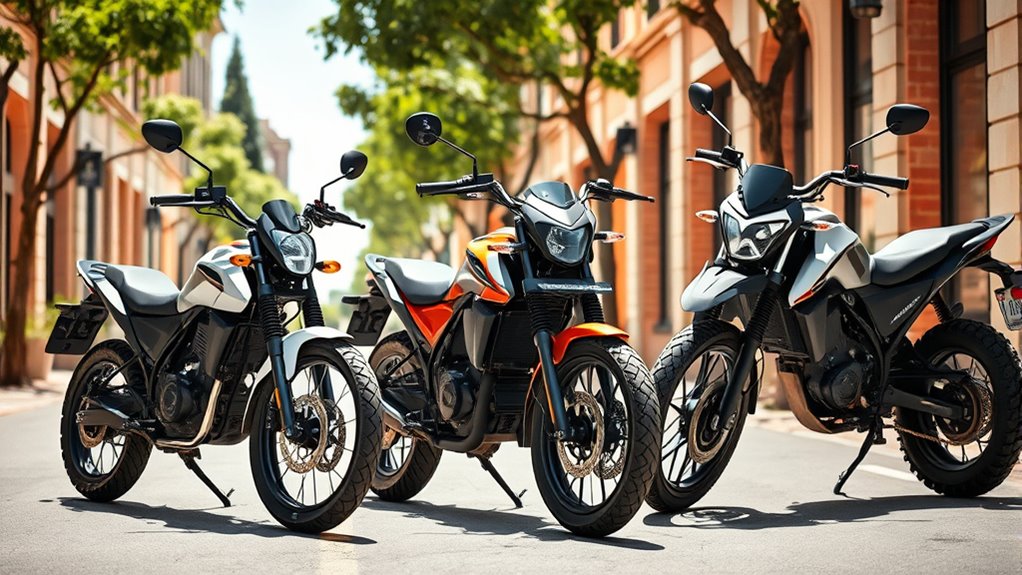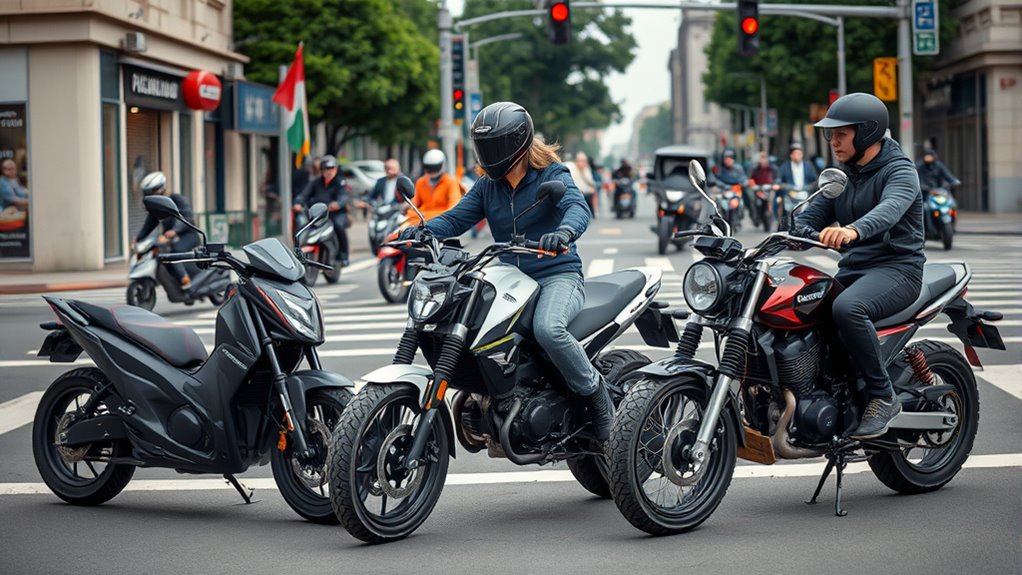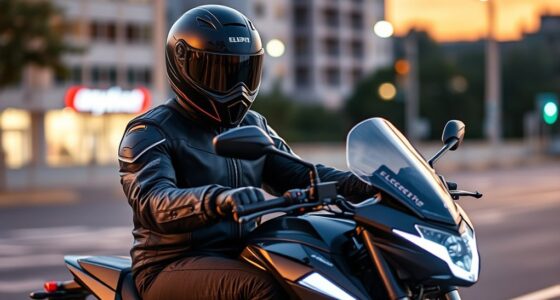Understanding the different classes of electric motorbikes helps you choose a bike that fits your riding needs and complies with local laws. Class 1 bikes offer pedal assist up to 20 mph, while Class 2 includes throttle control at the same speed limit. Class 3 bikes go faster, up to 28 mph, mainly for city commuting. Learning about power, speed limits, and regional restrictions guarantees you ride safely and legally—if you keep exploring, you’ll discover how each class suits different riding styles.
Key Takeaways
- E-bike classes are categorized mainly as Class 1 (pedal assist up to 20 mph), Class 2 (throttle up to 20 mph), and Class 3 (pedal assist up to 28 mph).
- Speed limits, motor power, and control methods differentiate each class, affecting legal use and riding restrictions.
- Class 1 offers pedal assistance only, ideal for casual riding, while Class 2 includes throttle control for convenience.
- Class 3 bikes are faster and often require safety gear and age restrictions; higher classes may need registration and licensing.
- Regional laws govern where each class can be ridden, with restrictions on trails, bike lanes, and off-road areas based on class and power.
Overview of E-Bike Classifications and Their Origins

The classification system for e-bikes began in Europe and has since become a global standard for distinguishing different types of electric bikes, mopeds, and motorcycles. This class system helps define how e-bikes are regulated, especially in the United States. The three main e-bike classes—Class 1, Class 2, and Class 3—are based on speed and motor assistance features, creating a standardized framework for legal riding. Class 1 bikes provide pedal assist up to 20 mph, while Class 2 bikes have throttle control also limited to 20 mph. Class 3 e-bikes, offering pedal assist up to 28 mph, face more restrictions. Since 2015, many U.S. states have officially adopted this classification system, ensuring consistency and clarity in regulation across jurisdictions. E-bike classification systems have been influenced by international standards established in Europe to promote safety and regulatory consistency.
Characteristics and Restrictions of Class 1 E-Bikes

Class 1 e-bikes only provide motor assistance when you’re pedaling, making them easy to use on shared paths and trails. They’re limited to a top speed of 20 mph, ensuring they stay within legal riding restrictions. These bikes are perfect for casual riding and commuting in areas where pedal-assist bikes are allowed. Additionally, color accuracy plays a vital role in enhancing the visual quality of related displays or screens used on these bikes, ensuring clear visibility in various lighting conditions. The father-daughter bond exemplifies how shared experiences can strengthen understanding and trust on and off the bike. Moreover, understanding the Power of Imagination can inspire riders to envision new routes and adventures, enriching their overall experience. Staying informed about credit card insights can also help cyclists manage expenses related to bike accessories and maintenance effectively. Maintaining industry trends awareness can help riders stay current with new safety features and technological advancements.
Pedal-Activated Assistance
Pedal-activated assistance on Class 1 e-bikes only engages when you’re pedaling, with no throttle option to activate the motor independently. This pedal assist system relies on cyclic sensors—either cadence or torque sensors—that detect your pedaling effort and trigger motor assistance accordingly. As you pedal, the motor provides support based on your pedaling power, making cycling easier without overpowering your effort. The assistance stops once you reach the legal speed limit of 20 mph, ensuring compliance with bicycle laws. Because the motor only activates during pedaling, Class 1 ebikes offer a natural riding experience, blending human effort with electric support. This setup makes them suitable for casual riding, commuting, and riding on shared pathways where motorized vehicles are permitted. Regular maintenance of the electrical components helps ensure consistent performance and safety during operation. Maintaining the motor system and understanding bike components are essential for optimal functionality and longevity of your e-bike. Proper battery care also plays a crucial role in maintaining overall system performance and extending the lifespan of your electric bike. Additionally, electric motor efficiency can influence how well your bike performs over time, highlighting the importance of keeping all components in good condition.
Speed Limitation Restrictions
Speed limitations define the boundaries within which Class 1 e-bikes operate legally and safely. These bikes are restricted to a maximum speed of 20 mph when the motor is assisting you. The power output from the motor only provides help while you’re pedaling, stopping when you cease pedaling. This pedal assist is activated through sensors that monitor cadence or torque, ensuring assistance is tied to your pedaling motion. Unlike some other e-bike classes, throttle control is typically not permitted on Class 1 bikes, so you can’t activate speed without pedaling. The speed restriction ensures you stay within legal limits, maintaining safety and compliance. Understanding these limits helps you ride confidently, knowing your Class 1 e-bike is designed to balance power, speed, and safety. Additionally, being aware of speed regulation can help you stay informed about the rules governing different e-bike classifications. For example, staying within the motor power output limits is essential to remain classified as a Class 1 e-bike and avoid legal issues. Moreover, comprehending market regulations can assist you in choosing the right e-bike for your needs and ensuring adherence to local laws. Maintaining awareness of battery safety guidelines can further enhance your riding experience and safety. Recognizing the importance of safety standards ensures that you select e-bikes that meet the necessary quality benchmarks.
Suitable Riding Areas
Are you wondering where you can ride your Class 1 electric bike legally? You’ll find that bike paths, shared use trails, and designated bike lanes are often permitted areas for these bikes. They work well on multi-use paths and certain mountain biking trails that allow pedal-assisted bicycles. However, trail access can be limited by trail restrictions and terrain considerations, so always check local trail regulations before riding. Class 1 e-bikes are generally excluded from high-speed motorized zones, as they are limited to 20 mph and operate only with pedal assist. Keep in mind that motorized zones and some trail restrictions may prohibit entry, ensuring you ride within permitted areas. Always verify local laws to stay compliant and enjoy your ride safely.
Features and Regulations Surrounding Class 2 E-Bikes

Class 2 e-bikes feature a throttle that lets you accelerate without pedaling, giving you effortless control over your ride. These bikes are designed with a twist, trigger, or thumb-operated throttle, enabling smooth acceleration. They’re limited to a maximum speed of 20 mph, regardless of whether you’re using the throttle or pedaling with pedal assistance. The electric motor, typically capped at 750W in the U.S., provides sufficient power without crossing into moped or motorcycle classification. Regulations vary by location, but many areas permit Class 2 ebikes on bike lanes and paths, making them accessible for urban commuting. Always check local rules, as some regions may have restrictions on motor power or where you can ride. Understanding these features helps you enjoy your ride while staying compliant. Managing electric motor power regulations is essential to ensure safe and legal riding. Properly storing your e-bike can also help maintain its performance and longevity. Additionally, being aware of relationships and trust issues can help prevent conflicts related to misused or misunderstood features.
Speed Capabilities and Usage of Class 3 E-Bikes

While many e-bikes are limited to lower speeds, Class 3 ebikes can assist you up to 28 mph, making them the fastest legal e-bikes on public roads and bike lanes. You’ll see a speedometer on these bikes to monitor your maximum assisted speed and assist level. The motor power is usually capped at 750W, providing enough torque for city commuting. Here’s a quick glance at their features:
| Aspect | Details | Restrictions |
|---|---|---|
| Max Speed | 28 mph | Off-road areas often restricted |
| Motor Power | 750W (sometimes higher) | Limited for legal use |
| Speed Monitoring | Speedometer included | Helmet use generally required |
| Age Requirement | 17+ years old | |
| Usage Restrictions | Roads and bike lanes only |
Additionally, motor power limits are set by regulations to ensure safety and compliance with local laws.
The Role and Regulations of Class 4 E-Bikes

Beyond the capabilities of Class 3 e-bikes, some models push into higher power and speed ranges, resembling dirt bikes or mopeds—these are known as Class 4 e-bikes. These off-road models often exceed the 750W power output and can reach speeds over 28 mph, sometimes surpassing 40 mph. Because of their increased capabilities, Class 4 e-bikes are generally classified as motorized vehicles, not bicycles, and are subject to stricter regulations. Many jurisdictions require licensing, registration, and insurance for these bikes. They are typically restricted from bike lanes and multi-use trails, aligning more with regulations governing dirt bikes and scooters. Understanding these rules helps you navigate where and how you can operate Class 4 e-bikes legally.
Technical Aspects: Power, Speed, and Legal Considerations

Electric motorbikes come with a wide range of motor powers, from 250W models designed for casual riding to over 1,000W bikes that excel in acceleration and hill climbing. Your choice of power directly influences speed and performance, but legal regulations vary by location. Many regions set speed limits for e-motorbikes, often around 28 mph, with higher wattage models capable of faster speeds. Motor wattage is a key factor in classification systems, determining whether your bike requires licensing or registration. Higher-powered bikes may need you to follow specific laws for mopeds or motorcycles, and some models offer switchable modes that bypass restrictions—though this can void warranties and violate regulations. Always consider local laws before selecting a bike based on power and speed.
Navigating Regional Laws and Riding Safety

Understanding regional laws and riding safety is essential for a smooth and legal electric motorbike experience. Regional laws vary widely, so you need to be aware of local regulations regarding classification, licensing, and safety requirements. Some areas restrict electric motorbikes to street-legal classifications, while others ban them from specific trails or paths. Many jurisdictions require registration, insurance, and proper licensing for higher-powered bikes. Knowing the local speed limits and power restrictions ensures you stay compliant and avoid penalties. Safety regulations often mandate helmet use, age restrictions, and proper licensing, which differ depending on your region’s classification system. Staying informed through official government resources helps you navigate regional differences and maintain safe riding practices.
Tips for Choosing the Right E-Bike Class for Your Needs

Choosing the right e-bike class depends on evaluating your riding environment and understanding local laws, since regulations can differ considerably between regions. For urban commuting or trail riding, consider which e-bike classes fit your needs: Class 1 offers pedal assistance only, ideal for controlled speeds up to 20 mph, while Class 2 includes throttle control, giving you a boost without pedaling. If you want higher speeds up to 28 mph, a Class 3 might be suitable, but check if it’s legal in your area. Match the e-bike’s power and features to your terrain and riding style. Always verify local laws to guarantee your chosen electric bike qualifies as a legal bicycle, so you can enjoy your ride without legal issues.
Frequently Asked Questions
What Does Class 1, 2, and 3 Mean in Electric Bikes?
When you ask about Class 1, 2, and 3 electric bikes, you’re asking how they’re categorized by speed and features. Class 1 bikes give pedal assist only, maxing out at 20 mph. Class 2 bikes add a throttle, still limited to 20 mph. Class 3 bikes can hit 28 mph, usually with pedal assist. These classes help you know where you can ride legally and what features to expect.
What Are the Different Classes of Electric Bikes?
Imagine electric bikes as a fleet of vehicles on a journey, each with different speeds and features. You’ll find Class 1 bikes, which assist with pedaling up to 20 mph; Class 2 bikes, with a throttle that also hits 20 mph; and Class 3 bikes, speeding up to 28 mph with pedal assistance. Some high-performance models go beyond, reaching over 40 mph, blurring the lines into electric motorcycle territory.
What Is a Class 4 Electric Bike?
A Class 4 electric bike looks like a moped or dirt bike, often with powerful motors over 750W and speeds exceeding 28 mph. You’ll find these bikes mainly used off-road or on streets where they’re allowed, and they usually have pedals and pedal assist. Keep in mind, regulations vary by location, so you might need licensing, registration, or insurance to ride one legally.
What Class Are Electric Motorcycles?
You’re wondering what class electric motorcycles fall into. Typically, electric motorcycles are classified as Class 1 or Class 2, depending on their speed and power. If it exceeds 28 mph or has more than 750W, it’s usually considered a motorcycle, requiring licensing and registration. Lower-powered models with pedal-assist features might be seen as electric mopeds or low-speed cycles. Your local laws will determine the exact classification and rules.
Conclusion
Choosing the right e-bike class depends on your riding needs and local laws. Did you know that e-bike sales have grown by over 50% globally in the past year? By understanding each class’s features and restrictions, you can ride confidently and legally. Whether you prioritize speed, safety, or versatility, selecting the right e-bike ensures a smooth, enjoyable experience on every ride. Make informed choices to enjoy the benefits of electric biking to the fullest.









